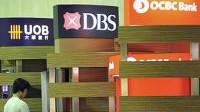
Singapore banks' asset quality seen as more defensive than HK banks
Barclays lists down the reasons why.
Comparing Hong Kong and Singapore banks’ consumer debt, which has been rising rapidly since the global financial crisis, Barclays has found that Singapore banks’ asset quality is more defensive than Hong Kong banks'.
This is due to Singapore’s lower loan size limits and greater discipline in pricing unsecured loans. Singapore also has a higher household savings rate and an accessible pension scheme (CPF) from which funds can be used to repay mortgage debt.
Among the banks, STAN (EW), BEA (UW) and OCBC (UW) have been most aggressive in growing their non-housing personal loans since 2008, said Barclays.
UOB (OW), OCBC (UW) and DSBG (EW) are most exposed to non-housing personal loans (10%+ of loans), the analysis further noted,
Here are the highlights of the investment summary from Barclays:
Based on our analysis of the banks’ loan books, we find, overall, Singapore banks’ non-housing personal loan exposure is more defensive than the Hong Kong banks’.
Singapore banks – largely secured, greater pricing discipline. Singapore’s growth in non-housing personal loans historically has mostly been on a secured basis (backed by deposits or investments) as unsecured personal lending rates have been high (11%+). Moreover, the MAS restricts the loan size on unsecured personal lending to 4 times monthly salary (and even lower for low-income earners). In contrast, Hong Kong’s non-housing personal loans are mostly unsecured as lending rates can be as low as 2-3%, and loan size can be up to 18x monthly income.
Singapore households – high savings rate and access to pension funds. Singapore has a high savings rate of 24% (vs Hong Kong’s 14%), Singaporeans can access pension funds (through the mandatory CPF scheme) to repay mortgage debt (Hong Kong’s equivalent, the MPF, cannot be used for housing debt) and Singapore households have a high proportion of liquid household assets (19% in cash and deposits). Moreover, despite Singapore’s higher consumer debt/GDP relative to Hong Kong, Singapore’s household debt to GDP is not high by historical standards, while Hong Kong’s is at a record high.
Standard Chartered, BEA and OCBC most aggressive in growth. STAN, BEA and OCBC have been most aggressive in growing non-housing personal loans since 2008, with a 5-year CAGR (2008-13) greater than 19%. UOB, OCBC and DSBG are the most exposed to non-housing personal loans, which account for more than 10% of their loan books. Despite Singapore’s higher level of household debt to GDP, we believe Singapore households are more defensive than Hong Kong households in the event of liquidity outflow and potential asset quality deterioration of the consumer book. This is because of Singapore’s high savings rate, access to CPF funds to repay housing debt and high proportion of liquid household assets (in currency and deposits).
Singapore has a high savings rate. Singapore has one of the highest savings rates in the world at 24%, behind China and India, which arguably have less developed social security systems and pension schemes. In comparison, Hong Kong’s savings rate is only 14%. As a result, we believe Singaporeans are better positioned to better tap into accumulated wealth to repay debt.
Singapore household assets increasingly skewed towards liquid asset. While property assets account for the bulk of household assets (49% of total), the proportion of liquid assets, namely cash and deposits, continues to rise and accounted for 19% of total household assets in Singapore in 2013. Household cash and deposits relative to household debt has risen from 0.8x in 2002 to 1.2x, implying that households have a much stronger capacity to repay debt with liquid assets. Singapore’s strong liquidity household assets to debt position provides an additional buffer to a potential debt servicing problems in the event of an economic downturn or when interest rates rise, in our view.
























 Advertise
Advertise






